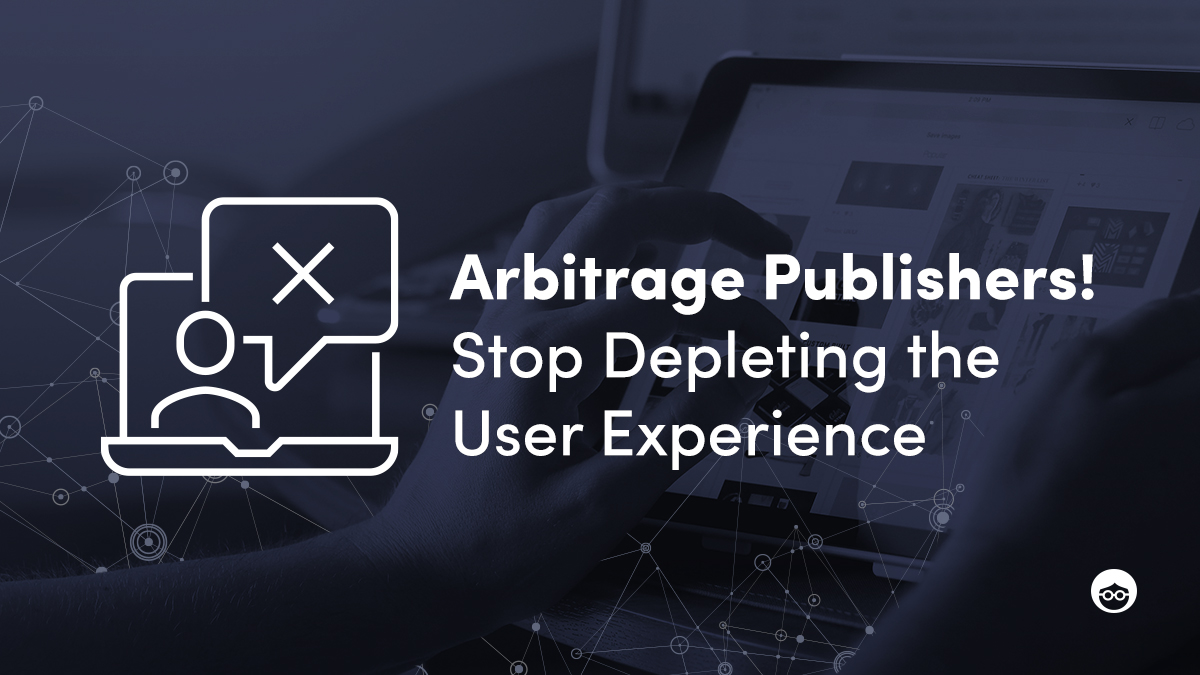4 Ways Your Arbitrage Model Is Depleting the User Experience (And How to Fix It)

The arbitrage game is not for everyone — it requires creativity, savviness, and hustle to take a site and turn it into a solid and consistent business.
Many content-dominated sites with arbitrage-based revenue models, especially those who rely solely on programmatic revenue, often get a bad rap for seemingly sacrificing the user experience for a quick and easy profit. But, just as we covered in our recent report with the IAB, Short-Term Versus Long-Term Profitability, prioritizing the user experience is key to maintaining a long-term publisher business, specifically from the buy-side context.
If you’ve noticed that bounce rates are high and engagement is low, this could mean that something on-site isn’t up to par with the enticing ads you’re putting out there.
The good news is that Outbrain has worked with arbitrage sites of all sizes for over a decade, and over the years, we’ve learned that there are ways to combat this.
Below are the four strategies to avoid for a better marriage between arbitrage and the user experience — and instead, actions to take to drive higher performance and overall site quality:
- Your headlines leave too much to the imagination
- Mo’ ads, mo’ problems
- The spinning wheel of death
- You’re milking that slide depth
1. Your headlines leave too much to the imagination
Short attention spans often call for short headlines — but short often means vague.
Of course, headlines that are too long will get cut off in an ad unit. And sure, these extremes might add a certain mystique to your ad — and hey, you might even enjoy a higher clickthrough rate for it. But, in either case, most consumers can’t be quite sure what they’re clicking into, which often drives much less time on site.
Finding that sweet spot for headline length means piquing your audience’s curiosity with just enough of a preview of what’s to come.
When promoting content on Outbrain’s network, we’ve found this Goldie Locks headline length to be 50-69 characters.
💡 Publisher Action: Keep a moderate headline length to up your chances of combining the best of both worlds — strong clickthrough rates and meaningful (cough cough, profitable) engagement.
2. Mo’ ads, mo’ problems
Keeping up with the short attention spans theme, consumers’ attention (and patience) can only spread so thin when ten display ads, two videos, and an interstitial are distracting them from the content they came to your site for.
And since arbitrage monetization depends on audience engagement, it’s important to set up your site experience in a way that makes them want to stay, rather than encourage them to leave with ad over-inundation. But oftentimes, content consumers get bombarded with an overly dense ad layout, making visiting the article feel like an ambush.
While it may be tempting to try maximizing programmatic revenue by loading as many ad units onto each article, slide, and reload as possible, too frequently this leaves the user with a crowded ad experience that overpowers the senses — in addition to slowing down the page load. And on the monetization front, programmatic yield decreases with an increased number of ads per page, rather than increases.
💡 Publisher Action: Dedicate at least 70% of your article to non-ad content, and avoid using pop-ups, loud auto-play videos, or other ad formats that disrupt the content that the consumer wants to see.
3. The spinning wheel of death
Between all the pixels, bidders, trackers, Oompa Loompas, and Keebler Elves working behind the scenes with every page load, the developmental work can get extremely clunky — quickly, at that. And one thing people are not trying to relive is dial-up internet speeds while consuming content (insert AOL’s bleeeeeep boooooop).
Here’s a telltale sign: If moving through your slideshow makes a laptop sounds like it’s about to take off into space just loading the next page, that slideshow very well might be abandoned. Or, if your infinite scroll layout takes a full minute to load the next chunk of the page, making people wonder, “…is that the end of the story?”, chances are they aren’t sticking around to find out.
With the likelihood of consumers abandoning a site that takes longer than 5 seconds to load increasing 90% — a high bounce rate or low slide depth can be indicative of the latency of your page load.
💡 Publisher Action: There are a bunch of tricks around lightening your page load — be sure to make finding the most beneficial option a priority.
- Work with your Development team to see if backend files can be compressed or images can be optimized.
- Identify and eliminate consistently slow ad networks.
- Utilize asynchronous ad codes to allow your content to reach the user before the ads, if possible.
4. You’re milking that slide depth
Candidly, I’m a big Foo Fighters fan. So, when I see an ad titled “Dave Grohl Hints At New Foo Fighters Album During a Recent Interview,” I need to know what was said — you bet I’m clicking.
But, what happens instead is, I get dragged through 35 slides about his birthplace, his favorite brand of peanut butter, and boxers vs. briefs before even getting to the subject of the interview. By slide 24, my patience is wearing down. By 31, I’m frustrated. And by 52, I’ve lost trust and decided to search whether or not there was even an interview.
When it comes to arbitrage, paginated articles tend to monetize higher than any other article layouts. But, filling an endless number of slides with a small amount of filler content sacrifices the user experience for the short-term KPI.
Instead, providing relevant and interesting information in each slide can facilitate meaningful user experiences, while also increasing the chance of the consumers staying on-site rather than bouncing (when – or if – they reach the end of a slideshow).
Of course, you need to hook people into your content, and of course, you need to drive revenue with each slide load. But, the balance of spreading out the ad units across a number of slides that is meaningful to the user and to your ROAS is one that has no one-size-fits-all solution, but is an important code to crack.
💡 Publisher Action: Make sure each slide offers a higher content-to-ad ratio, providing each with a meaningful, interactive experience. And for paginated news or stories, highly-scaling slideshows hover around 27-35 slides, while listicles can have more flexible lengths.
Balancing Short-Term Profits With Long-Term Strategies
On the surface, arbitrage revenue models might seem like a too-easy way to make fast profits from ad revenue. And hey, if you’re only in it for the short game, you could be right!
But, if your goal is to sustain a long-term profit and avoid frustrating your audiences, we highly recommend taking behavioral cues to build an experience that’s mutually beneficial.
If you’d like to show people what a great experience your site can offer (and boost your ROAS along the way, natively), sign in to your Outbrain dashboard, or register here to get started.













